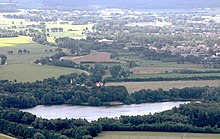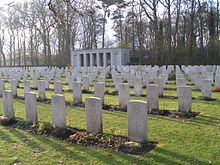Wildeshauser Geest Nature Park
Zweckverband Naturpark Wildeshauser Geest is the sponsor of the nature park of the same name in western Lower Saxony , which is mainly in the district of Oldenburg , but also partly in the districts of Cloppenburg , Vechta and Diepholz .
Term geest
The term Geest is a noun from the Low German adjective güst , which means dry and barren. It is an old moraine landscape, shaped by the sandy deposits of the Ice Age. In the lowlands in between there are wet meadows, and bogs if the drainage is poor.
Location of the Wildeshauser Geest Nature Park
The area of the Wildeshauser Geest Nature Park is located in the North German lowlands . It extends mainly over the Ems-Hunte-Geest , a natural spatial unit of the third order, mainly over the Delmenhorster Geest subunit , but also over the eastern part of the Cloppenburger Geest and the northwestern part of the Syker Geest . In the north-west of the Wildeshauser Geest, the easternmost section of the Hunte-Leda Moorniederung is included, which is included in the East Frisian-Oldenburg Geest .
North bordering the Wildeshausen Geest the marshes of Hunte and Weser (a portion of which belongs entirely to the south nor to Wildeshausen Geest), south one to close to the Wiehengebirge reaching Moor belt with Big Moor, Wietingsmoor and Sulinger Moor that the Dümmer- Geest lowering be attributed. In the north-west of the nature park, the landscape of the Wildeshauser Geest nature park also merges into large moor areas, namely the East Frisian-Oldenburg Geest. The Geest plateaus in the nature park are mostly 50 to 60 m above sea level. NN, in the southeast not belonging to the nature park near Nienburg even up to 80 m. The impressive eastern Geestrand rises between Hoya and Syke about 40 m above the Weser lowlands , west of Syke it is another 20 to 30 m. On the southern edge there is a height difference of 20 m here and there, often none at all.
The rivers of the nature park mainly flow from south to north. In addition to the Hunte coming from the Wiehengebirge, these are above all the Delme , the Klosterbach and the Hache , which arise in the Delmenhorster Geest . The valleys of these rivers give the landscape a characteristic structure and undulation. On the northern edge of the nature park, between Ganderkesee and Barrien , these bend to the east. Smaller brooks of the Syker Geest gather in low waters flowing northwards like the Süstedter Bach .
In the center of the park are Wildeshausen , the district town of the Oldenburg district, and Harpstedt .
Land use
Today's land use is a mosaic of forests, fish ponds, arable land, grassland, the z. T. is divided by wall hedges. The forest is partly mixed forest, partly coniferous forest. The proportion of forest is highest in the Wardenburg - Twistringen - Syke triangle , which also includes Wildeshausen and Harpstedt . In the far south, the Wildeshauser Geest Nature Park also includes moorland, some of which can still be used commercially.
History of the natural park
The Wildeshauser Geest Nature Park was designated in 1984 and expanded in 1993 so that it now almost completely encompasses the Delmenhorster Geest. Its area is approx. 1532 km² with an east-west extension of around 50 km. It is one of the largest in Germany. 4% of the area of the nature park are nature reserves and 50% landscape protection areas. Forests can be found on 20% of the area.
Cultural monuments
The prehistoric evidence, numerous megalithic structures ( barrows ) and burial mounds , which for the most part form stations on the route of the megalithic culture, are particularly impressive . The most famous are the plants:
- Ahlhorner cellar stones (2 systems)
- Glaner bride (2 systems)
- Heath sacrifice table (Visbek)
- High stones (Aumühle)
- Small kneading stones (3 systems)
- Millstones (Varnhorn)
- Pestrup burial ground (Wildeshausen)
- Schmeersteine (Varnhorn)
- Steinloger cellar stones (2 systems)
- Visbek bride (Wildeshausen)
- Visbeker groom (Großenkneten)
In the early Middle Ages, the two fortifications Arkeburg (municipality of Goldenstedt) and Hünenburg (municipality of Twistringen) were built. The ring wall of the Arkeburg is still preserved today. The Hüneburg was partially reconstructed; The gate system and a farm building of the former castle were reconstructed.
The most important historical buildings from the Middle Ages and early modern times include the collegiate church in Bassum , the monastery ruins in Hude , the Gothic town hall and the Alexander church in Wildeshausen and the Amtshof in Syke . In addition to the historic forest ranger's office, Neubruchhausen has a small barn district . There is also one on the western outskirts of Harpstedt. The large number of preserved sheep pens and functioning watermills in the Wildeshauser Geest is striking .
The three museum railways that run through the Geest are also to be regarded as cultural monuments : The narrow-gauge railway from Bruchhausen-Vilsen to Asendorf was the first museum railway in Germany (1966, German Railway Association ) and has many annual operating days. The full-gauge museum train “Kaffkieker” (from Syke to Hoya ) also runs through Bruchhausen station . The also full-gauge museum railway from Delmenhorst to Harpstedt is called Jan Harpstedt. Trips through the Goldenstedter Moor with the moor train or the little train “Jan Spieker” are also “hearty”.
In the Wildeshauser Geest Nature Park there is also the " Sage War Cemetery ", where soldiers from the Commonwealth of Nations are buried, who died at the end of the Second World War during the occupation of Germany and its liberation from the rule of National Socialism .
tourism
The nature park sponsor and umbrella association for tourism is the Wildeshauser Geest Nature Park Association, based in Wildeshausen, to which cities and municipalities also belong in addition to the districts of Diepholz, Oldenburg and Vechta. The association is an institution under public law. In the work of the tourism association, the Zweckverband is responsible for external presentation and marketing. He operates the website of the nature park, publishes brochures, places advertisements and presents himself at trade fairs. As the body responsible for the nature park, the association continues to try to reconcile tourism and nature conservation issues and is asked about major interventions in the landscape in order to strike a balance between the interests of the nature conservation representatives and the tourist actors. The whole Wildeshauser Geest is a popular cycling area, the Middle Hunte is a paddling area. All cities in the area except Sulingen have a train station with passenger transport.
In May 2009 the street of the megalithic culture was opened. It connects many of the megalithic systems of the Wildeshauser Geest with each other and with the systems in Emsland and the district of Osnabrück . Since 2008, a new section of the Lower Saxony Mill Road has been running through the Wildeshauser Geest, which begins in Harpstedt and leaves the nature park behind Goldenstedt.
literature
- Hans Huntemann: The Wildeshauser Geest. Paths and walks. Oldenburg ³1981, 136 p. M. 7 photos, 2 drawings, 1 facsimile and 52 map sketches
- Helga Klöver: Wildeshauser Geest. Discover and experience cities and landscapes in the nature park. An illustrated travel guide. Bremen 2000, 208 p. M. numerous Fig.
- Harald Witt: The most beautiful bike tours between Hunte, Weser and Wümme. Nature - culture - history. Bremen 2003, 207 p. M. 96 Fig.
- Nils Aschenbeck u. Rüdiger Lubricht (photos): Churches and cemeteries on the Hunte and Weser. Oldenburg 2000, 48 p. M. Fig.
- Ernst Andreas Friedrich : Natural monuments of Lower Saxony . Hanover 1980, ISBN 3-7842-0227-6
See also
Web links
- The Wildeshauser Geest Nature Park in the Northwest culture portal
- Hune beds and passage graves in the Wildeshauser Geest in the culture portal Northwest
Individual evidence
- ^ " Zweckverband Naturpark Wildeshauser Geest": Burgwall "Arkeburg". Goldenstedt, municipality of Goldenstedt
- ↑ Association of Wildeshauser Geest Nature Park: "Hünenburg". Stöttinghausen, Twistringen municipality
- ↑ Bernd Rothmann: Schafkoben in the Wildeshauser Geest (PDF; 1.7 MB). In: Bürgerpost . Issue 9. pp. 12–15
- ↑ Zweckverband Naturpark Wildeshauser Geest: Watermills
- ^ Course of the Lower Saxony Mühlenstraße through the district and the city of Oldenburg
- ^ Course of the Lower Saxony Mill Road through the Vechta district

































